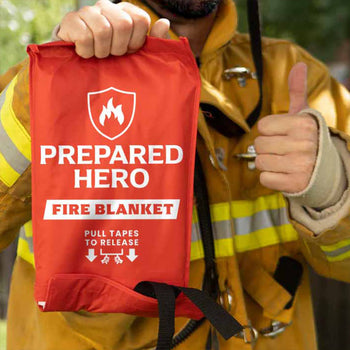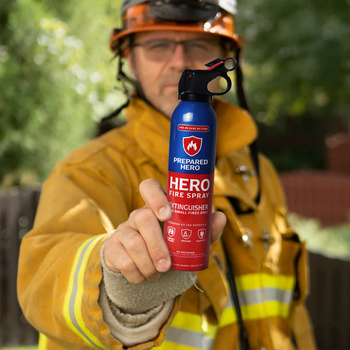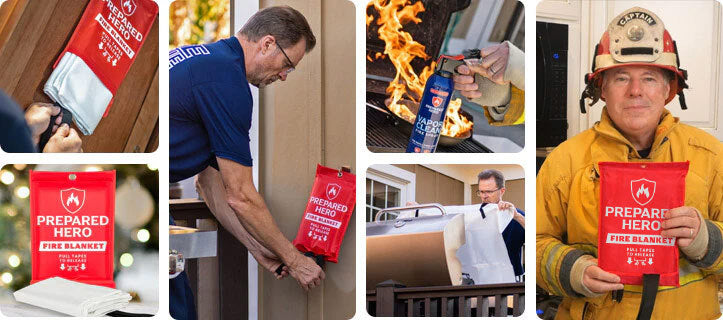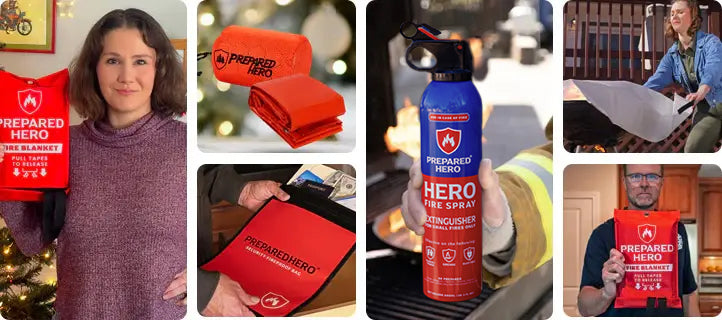Where you put your smoke detectors matters just as much as installing them. Proper placement makes sure they can detect...
The last thing on your mind is your chimney when you're enjoying your fireplace. But things can go south fast if you don't check it before lighting those winter fires. You see, a dirty chimney can cause dangerous fires that put lives at risk. In fact, the US Fire Administration reports that chimney-related fires make up 77% of heating fires in homes. So, keeping your chimney clean and safe is a must. But how exactly do you do this?
Keep on reading to learn how to prevent and put out a chimney fire. We’ll also explain the signs of a chimney fire, how dangerous it is, and what to do when one breaks out.
How Serious Is a Chimney Fire?

A chimney fire can be serious, even though most people don't realize their chimney has had one. While some chimney fires are big and loud, most are quiet and slow. This type of fire often starts from a stray spark or heat that ignites creosote buildup. Creosote is a sticky substance from burning wood. It can burn for a long time once it builds up and causes high temperatures that damage your chimney and home.
The damages include cracked chimney tiles, melted roofing, or structural problems. The most dangerous part is that it can create openings for carbon monoxide to seep into your home. This could lead to poisoning or a bigger structure fire.
In addition, a small spark could become a major fire if you don’t immediately fix the damages caused by a chimney fire. That's why it's important to get your chimney inspected every year. Keep an eye out for signs like cracks in the chimney or melted parts as well. If you see any, call a professional to inspect your chimney right away. Taking care of it keeps your home and family safe from serious harm.
What Are the First Signs of a Chimney Fire?

Chimney fires can happen without warning. Whether it's a fast-burning fire or a slow-burning menace, recognizing the early signs is crucial. Here are the warning signs of a chimney fire:
Signs of a Fast-Burning Chimney Fire
You’ll likely know if a fast-burning chimney fire occurs. Here are the most common signs of a fast-burning chimney fire:
Flames or Sparks
Flames or sparks are among the most obvious signs of a chimney fire. You’ll see flames or flaming creosote pieces coming from your chimney's top. Even if you can't see the flames directly, the sparks shooting out of your chimney make it clear.
Loud Noises
Chimney fires often make a lot of noise. If a fast-burning one occurs, you’ll hear a cracking, popping, or roaring sound. It’s similar to the sound of a bonfire or a large vehicle coming toward you.
Heavy Smoke
A chimney fire creates a lot of smoke. You may notice dense smoke either coming from the top of the chimney or billowing inside the fireplace.
Strong Burning Smell
If there’s a strong burning smell in your house, your chimney is likely on fire. Pay attention to any unusual odors in your home.
Signs of a Slow-Burning Chimney Fire
Slow-burning chimney fires are harder to notice. They burn quietly and may not be obvious until someone inspects your chimney. Here are the most common signs of a slow-burning chimney fire:
Changes in Color
If the creosote inside your chimney turns grey or metal parts are discolored, a slow-burning fire might be brewing. This happens when heat builds up but doesn’t flare up into a large flame.
Cracks and Damage
A slow fire can also damage your chimney’s structure. You may notice cracks in the flue tiles or the masonry. Sometimes, damage to nearby roof structures like vents or antennas is visible.
Creosote Pieces Outside
Excessive heat from a slow-burning fire causes pieces of creosote to fall on the roof or ground. These are signs that the fire has been burning inside the chimney, causing damage you can’t always see.
What to Do When Your Chimney Is on Fire

Knowing what to do can make all the difference if a chimney fire occurs. Find out how to respond to a chimney fire below:
1. Stay Calm and Call for Help
The first thing you need to do is stay calm. Immediately call the fire service and tell them there's a chimney fire. They are trained to handle these situations.
2. Try to Put Out the Fire Safely
Try to extinguish the fire only if it’s small and you feel safe. Use a carbon dioxide or foam fire extinguisher to do this. You can also splash small amounts of water or sand on it, but avoid dumping a whole bucket. Doing this produces steam and makes things worse. Never use salt because it can produce toxic gas.
3. Close Air Vents and Dampers
Close all air vents and dampers if you have a stove chimney. This will cut off the oxygen supply to the fire and help reduce its intensity.
4. Alert Everyone and Evacuate
Make sure everyone in the house knows about the fire. If the fire is spreading or becoming dangerous, leave immediately. Don’t waste time trying to salvage belongings—getting out quickly is the most important thing. Then, account for everyone and wait outside for the authorities. Don’t come back in for any reason. Remember, material things can be replaced, but lives can’t.
How to Prevent a Chimney Fire

Chimney fires can damage your home, but they can be prevented. From regular cleaning to using the right materials, here are simple steps you can take to keep your chimney safe:
1. Keep Your Chimney Clean
Over time, creosote builds up from burning wood. If left unchecked, it can ignite. According to the National Fire Protection Association (NFPA), chimneys should be cleaned at least once a year.
Aim for a chimney sweep every three months if you're using wood. If you use smokeless fuels, an annual cleaning will suffice. Coal stoves should be cleaned twice a year, while oil and gas appliances only need an annual check-up.
Cleaning your chimney isn’t just about safety. It’s also about efficiency. A clean chimney has better airflow, so your fire will burn hotter and cleaner. This reduces the amount of smoke and creosote that forms inside it.
2. Use Well-Seasoned Wood
Burning dry, seasoned wood also prevents chimney fires. Freshly cut wood is full of moisture, so it produces more smoke and less heat. This excess moisture creates more creosote in the chimney, leading to a higher risk of a chimney fire. On the other hand, properly seasoned wood has less than 20% moisture content. Hardwoods like oak, hickory, and maple are the best options. It’s because they burn longer than softwoods like pine, which produces more creosote.
3. Use a Chimney Cap
A chimney cap is a simple but effective tool that prevents chimney fires. It covers the top of your chimney and keeps out debris like leaves, twigs, and animal nests. Debris can block the flue and create dangerous conditions. A chimney cap also prevents sparks from escaping, which is crucial if you have a thatched roof or live in a fire-prone area. The cap also helps keep rain and snow out and protects your chimney from corrosion.
You can easily find affordable chimney caps made from galvanized steel. Some models even improve draft efficiency, helping smoke and gases exit your chimney faster.
4. Don’t Burn Dangerous Materials
Avoid burning anything that isn’t wood. Materials like cardboard, plastic, or treated wood can release harmful chemicals or cause dangerous flare-ups. Even old furniture, wrapping paper, or glossy magazines can release toxins into the air. The best materials for kindling are small twigs or branches. On the other hand, crumpled newspapers and dried pinecones work well for tinder. Never, under any circumstances, use flammable liquids like gasoline or kerosene to start a fire. They quickly ignite and can cause an explosion.
5. Burn Cleanly
How you burn also affects the amount of creosote that builds up inside your chimney. Low-temperature fires tend to produce more smoke and create more creosote, which increases the risk of a chimney fire. So, opt for hot, fast-burning fires.
The top-down burning method is also a great technique. Start by placing bigger logs at the bottom. Follow it with kindling and top with tinder. This setup allows the fire to burn hotter, produces less smoke, and creates less creosote.
Never leave a fire burning overnight or unattended for long periods, too. Make sure your fire is completely out before going to bed or leaving the house. Also, spread the ashes around and make sure the fire is fully extinguished.
6. Have Professional Inspections
Experts can detect issues that are hard to spot on your own. These include cracks in the flue, liner damage, and blockages. The NFPA recommends having your chimney inspected at least once a year. However, additional inspections are needed if you use your chimney more than usual. Professional check-ups make sure your chimney minimizes fire risks and keeps your home safe.
How to Put Out a Chimney Fire

Chimney fires can spread quickly, so always call the fire department first. While firefighters usually do the steps outlined below, it's good to know what they do to keep your home safe. Please note that these steps aren’t for the average person.
1. Cut Off the Oxygen Supply
The first thing firefighters will do is stop the flow of oxygen to the fire. By reducing oxygen, the fire loses fuel and starts to die down. Ideally, the homeowner would have shut off the oxygen before the firefighters arrived. If not, the fire department will do it.
They do this by closing the door and the air intake vents of wood stoves and fireplace inserts. However, this might not be possible with an open fireplace, so reduce the fire’s intensity before the firefighters arrive. But only do this if you’re capable and it’s safe.
2. Cover the Area
Next, the firefighters will cover the area around the stove or fireplace to prevent further damage. They spread a fire-resistant cover (often a tarp) in front of the stove or fireplace to catch any hot embers, ashes, or extinguishing agents that may fall out.
The cover helps contain the mess and protects your floors from getting scorched. Fire-resistant cloth (like the ones used in fire blankets) is the best option because plastic tarps would melt under the heat.
3. Ventilate the House
Fighting a chimney fire means having smoke inside the house, especially if the wood is being removed from the firebox. So, before doing anything else, firefighters will set up ventilation to clear the smoke.
They’ll often use a method called positive pressure ventilation to push the smoke out of the house. This means they’ll open a window or door on the opposite side of the house to direct the smoke outside. The goal is to make sure the air stays clear so the smoke doesn't spread throughout your house.
4. Put Out the Box Fire
Once the area is protected and ventilated, the firefighters will put out the fire in the stove or fireplace. There are a couple of ways to do this. Most of the time, firefighters will use water. They’ll only use enough to get the flames under control. In particular, they’ll use a small bucket of water, a garden sprayer, or a special air-pressurized water extinguisher. The water helps knock down the flames. If they’re lucky, the steam from this process can travel up the chimney and help extinguish the fire inside the flue.
Firefighters can also use a dry chemical agent. This works well, but it can make a mess. They often sprinkle the agent over the fire to put it out. They'll remove the burning wood once the fire inside the stove or fireplace dies.
5. Remove the Burning Wood
Once the fire in the firebox is under control, the firefighters will remove any burning wood from the stove or fireplace. They usually have tools like long-handled metal tongs or a metal bucket for this. They’ll carefully pick up the wood, carry it outside, and make sure not to drop any burning embers along the way. Once outside, they’ll fully extinguish the wood using a fire extinguisher. Doing this prevents any remaining sparks from reigniting the fire.
6. Access the Roof
While the firefighters are handling the fire inside, others will prepare to go up on the roof. They should check the roof because the chimney fire could have spread there. Firefighters will set up ladders from the ground or use aerial devices to reach the chimney.
Then, they’ll carefully position the ladder, secure it, and make sure it doesn’t lean against the chimney. Older chimneys can be unstable, so this is a must. If the roof is made of flammable material, they’ll bring a hose to douse any smoldering areas.
7. Extinguish the Chimney Fire
Once the wood is removed and the roof is secured, the firefighters will put out the chimney fire. They can do this in many ways, depending on the situation. Some fire departments use water, while others prefer dry chemical agents.
Firefighters will carefully use water to avoid causing damage to the chimney. Too much water could crack the flue, which can lead to bigger problems down the road. Some departments use a special chimney nozzle that sprays a fine water mist. This turns to steam and smothers the fire without causing damage.
On the other hand, firefighters will sprinkle dry chemical agents down the chimney. This helps put out the fire quickly but can make the area messy. There are also chimney fire extinguishing cartridges called chimney bombs that work like road flares. They drop them into the firebox, and the gas released by the flare helps put out the fire.
8. Check for Any Spread or Extension
Once the fire is out, the firefighters will check the surrounding areas for any signs that the fire has spread. They’ll look around the walls, roof, and attic. They’ll also check for glowing embers or discoloration in the materials nearby. If they find anything suspicious, they’ll inspect the area further to make sure the fire hasn’t spread. They’ll also remove any smoldering item and make sure it’s fully extinguished.
How Do Chimney Fires Start?

Chimney fires usually start because of dangerous creosote buildup inside the chimney. When wood burns, it releases gases that mix with air and catch fire once they get hot enough (around 1,100°F or 593°C). If the fire doesn’t burn enough, the unburned gases condense on the stove pipes and chimney walls, forming creosote. This sticky, tar-like substance comes in various forms, from a sooty powder to a hard glaze. Over time, the creosote layer thickens and becomes more flammable.
Creosote burns at extremely high temperatures. The heat from this fire can crack the chimney liner, warp metal liners, and spread to the rest of the house. The fire can also be so intense that flaming balls of creosote may shoot out of your chimney and ignite your roof and other nearby structures. The fire can cause the chimney to collapse or explode if left unchecked. In worst cases, the intense heat can also cause wooden parts of the house to catch fire.
Several factors lead to creosote buildup. For one, the chimney or flue might be too large for the appliance it serves. When the flue is too big, gases cool down and condense on the chimney's walls. In addition, burning wet or green wood creates more creosote. Poor burning habits, like restricting airflow, can also lead to creosote buildup. Lastly, a neglected chimney or an outdated stove that burns inefficiently adds to the problem. Remember, regular chimney cleaning and proper stove maintenance prevent dangerous chimney fires.
Can You Let a Chimney Fire Burn Out?

No, you should not let a chimney fire burn out on its own. It’s crucial to call the fire department right away. Chimney fires are often caused by creosote, a highly flammable byproduct that forms when smoke cools and condenses inside the chimney. This black, sticky substance builds up over time and can easily ignite without you knowing. If left unchecked, the fire can quickly spread and cause serious damage to your home. Always prioritize safety and never leave a chimney fire alone.
How Long Does a Chimney Fire Last?

A chimney fire can last 20 minutes or more, depending on the situation. Even a small amount of creosote buildup—just 1/8 inch—can keep the fire going for up to 20 minutes. If the buildup is thicker, the fire could last longer and cause more damage. However, if the fire is small and you catch it early, it may burn quicker. Either way, you should call the fire department right away.
How Often Do Chimney Fires Occur?

Chimney fires happen more often than we might realize. In fact, an average of 25,000 chimney fires are reported each year in the US. These fires are mostly caused by creosote buildup or improper chimney maintenance. Creosote is a flammable by-product of burning wood. It can easily catch fire if not cleaned regularly. Even though chimney fires aren’t something everyone experiences, they’re a risk for homeowners who don’t properly maintain their chimneys. So, keep your chimney clean and regularly check it to prevent these fires from happening.
How Hot Can a Chimney Fire Get?

Chimney fires can burn at temperatures over 2,000°F or 1,093°C. The fire can burn longer and more intensely if the buildup is thicker. In particular, a 1/4 inch of creosote buildup can expand up to 2 inches when burned, increasing the intensity of the fire. The heat from these fires can also warp metal liners, crack linings, and break tiles. It can also burn nearby walls, ceilings, or other surfaces.
Can a Chimney Cause a Fire?

Yes, a chimney can cause a fire if it's not properly maintained. Over time, creosote can build up inside the chimney. This buildup can ignite a dangerous chimney fire if it gets hot enough. This can damage the chimney liner, crack the masonry, or burn nearby parts of the house. Poor wood-burning habits, like using wet wood or not getting enough airflow, can also make things worse. Regular chimney cleaning and inspections help prevent fires and keep your home safe.
What Happens When a Chimney Catches Fire?

A chimney fire is usually caused by creosote buildup. Creosote is a tar-like substance that’s produced when wood burns. Over time, this accumulates, thickens, and becomes highly flammable. A small spark or rise in temperature can ignite the creosote and start a chimney fire.
The fire can quickly grow because of the highly flammable creosote lining the chimney. The heat can reach temperatures over 2,000°F and cause severe damage to the chimney structure. The fire can also crack or warp the metal flue lining, leading to bigger problems.
The most dangerous consequences of chimney fires are carbon monoxide leaks. The heat can break the protective barriers in the chimney. As a result, carbon monoxide that normally vents out of your home can now seep inside. This puts everyone at risk of poisoning.
Plus, the damage lets future fires spread quickly if the chimney isn't repaired. For instance, a stray spark or another chimney fire could easily escalate into a house fire, especially if the first fire weakened the chimney. A fireplace with a cracked flue or warped metal lining can make this worse.
What Happens After a Chimney Fire?

Several things happen after a chimney fire. First, the heat from the fire can cause cracks or break the chimney liner, which helps protect your home from heat. If the liner gets damaged, heat or harmful gases like carbon monoxide can enter your house.
The intense heat can also cause structural damage to the chimney. This means that parts of the masonry or the chimney crown crack and weaken the overall structure. In some cases, it makes parts of the chimney unstable and leads to collapse.
While creosote buildup usually causes chimney fires, the aftermath could leave significant amounts stuck inside. This can further clog the flue, block the airflow, and make it harder for the chimney to vent properly.
There can also be lingering odors after a chimney fire. Plus, smoke damage could affect the air quality in your home. So, it’s essential to have a professional look at everything thoroughly. They’ll assess the damage, clean any creosote buildup, and make sure your chimney is safe to use again.
Conclusion
Chimney fires are a serious risk, but they can be prevented. Regular cleaning, proper wood-burning practices, and annual inspections can keep your chimney in top shape. Knowing the warning signs and how to act quickly also keeps your family safe. Don’t wait until it’s too late—check your chimney, keep your fire kit (fire spray or fire extinguisher, fire protection gloves, and extra large fire blanket) ready, and get it cleaned and inspected regularly.
Do you want reliable, easy-to-use, and affordable tools to put out small fires before they spread? Check out Prepared Hero’s fire prevention tools here, and get up to 51% off on certain items. Stay prepared, hero!


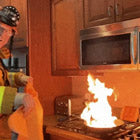 Fire
Fire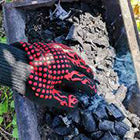 Safety
Safety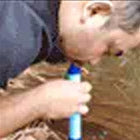 Survival
Survival Protection
Protection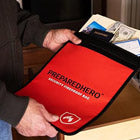 New
New
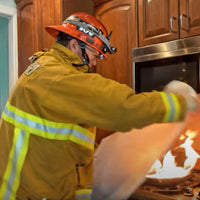 Fire
Fire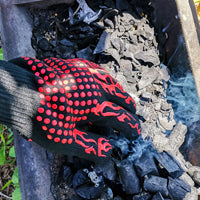 Safety
Safety Survival
Survival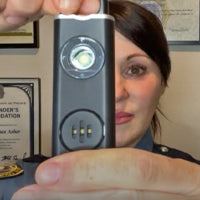 Protection
Protection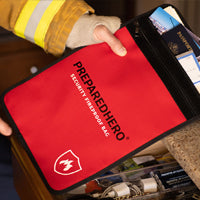 New
New
